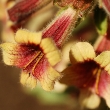Background

- Rehmannia has been used extensively in traditional Chinese medicine (TCM). Although thorough clinical trials are lacking, rehmannia has been used to treat rheumatoid arthritis, asthma, urticaria (hives), and chronic nephritis (kidney inflammation) in Chinese studies. Rehmannia may also be used to prevent the suppressive effects of corticosteroid (steroid) drugs.
- Rehmannia looks promising in treating aplastic anemia, mitigating side-effects of chemotherapeutic agents and HIV medications, curing obdurate eczema (dry skin), relieving pain from lung or bone cancer or disc protrusion, and helping ameliorate lupus nephritis (kidney inflammation) and type 2 diabetes with hyperlipidemia (high cholesterol). However, presently, there are no high-quality, large randomized, controlled trials supporting the efficacy of rehmannia for any of these indications.
- Rehmannia is in the Pharmacopoeia of the People's Republic of China. However, it is not on the United Kingdom's General Sale List, and is not covered by a Commission E monograph in Germany. The U.S. Food and Drug Administration (FDA) has not granted generalized recognized as safe (GRAS) status to rehmannia; it is available in the United States as a dietary supplement under the Dietary Supplement Health and Education Act of 1994.
Scientific Evidence
| Uses | Grade* |
| Aplastic anemia (adjuvant)
Rehmannia is frequently recommended to mitigate duration and severity of aplastic anemia. Although preliminary results appear promising, additional study is needed to draw a firm recommendation. |
C |
| Hypopituitarism (Sheehan's syndrome)
Rehmannia glutinosa has been used in the treatment of Sheehan's syndrome. However, the magnitude of therapeutic effects of rehmannia on Sheehan's syndrome remains unclear. More research is necessary in this area. |
C |
Tradition
- Adrenal tonic, allergies, amenorrhea (absence of menstruation), anemia, antifungal, antipyretic (fever reducer), anti-inflammatory, asthma, autoimmune diseases, blood clotting disorders, cancer pain (bone cancer), cataracts, central nervous system disorders, chemotherapy adverse effects, cognitive processing, coronary heart disease (postmenopausal symptoms), dementia, diabetes mellitus type 2, diuretic, dizziness, dysmenorrhea (painful menstruation), eczema (dry skin), fatigue, fever, gastric adenoma (benign tumor), hair tonic (premature graying), hearing damage (gentamicin-induced), hematopoiesis (stimulation of blood cell production), hematuria (blood in the urine), HIV (medication side effects), hyperlipidemia (high cholesterol), hypertension (high blood pressure), hypotension (low blood pressure), hypoxia (very low oxygen levels, nocturnal), immunosuppression, laxative, liver protection, lumbar disc herniation (intervertebral disc protrusion), lung cancer, lupus nephritis measles, menorrhagia (heavy menstrual bleeding), metrorrhagia (irregular uterine bleeding), nephritis (inflamed kidney, chronic), nosebleeds, rheumatoid arthritis, sarcomas (cancer of the bone, cartilage, fat, muscle, blood vessels, or other connective or supportive tissue), skin disorders, thirst, tinnitus (ringing in the ears), tonic, tranquilizer, urticaria (hives), vasoregulator, vasorelaxant, vertigo.
Dosing
Adults (18 years and older):
- There is no proven safe or effective dose for rehmannia. Herbal decoctions used in clinical trials have contained 12-30 grams of rehmannia. For Sheehan's syndrome, 90 grams of cleaned and finely chopped Rehmannia glutinosa root added to 900 milliliters of water and boiled down to 200 milliliters has been used in three day courses with an intermission of three, six, and 14 days. After a one-month cessation, the second round of treatment commenced. Another dosing regimen used was 45-50 grams of Rehmannia glutinosa daily in five-day courses with an intermission of five days each time for 2-5 months.
Children (younger than 18 years):
- There is no proven safe or effective dose for rehmannia in children.
References
- Cui ZB, Yuan YD, Liu SH, et al. [Intervention effect of tongfei mixture on nocturnal hypoxia in patients with chronic obstructive pulmonary disease]. Zhongguo Zhong Xi Yi Jie He Za Zhi 2004;24(10):885-888. View Abstract
- Deng YY, Chen YP, Wang L, et al. [Clinical study on treatment of mid-advanced crescentic nephritis by qingre huoxue recipe]. Zhongguo Zhong Xi Yi Jie He Za Zhi 2004;24(12):1084-1086. View Abstract
- Kamei T, Kumano H, Iwata K, et al. The effect of a traditional Chinese prescription for a case of lung carcinoma. J Altern Complement Med 2000;6(6):557-559. View Abstract
- Kim H, Lee E, Lee S, et al. Effect of Rehmannia glutinosa on immediate type allergic reaction. Int J Immunopharmacol 1998;20(4-5):231-240. View Abstract
- Kim HM, An CS, Jung KY, et al. Rehmannia glutinosa inhibits tumour necrosis factor-alpha and interleukin-1 secretion from mouse astrocytes. Pharmacol Res 1999;40(2):171-176. View Abstract
- Liang R, Chen MR, Xu X. [Effect of dandi tablet on blood lipids and sex hormones in women of postmenopausal stage]. Zhongguo Zhong Xi Yi Jie He Za Zhi 2003;23(8):593-595. View Abstract
- Liang S. TCM treatment for 50 cases of acute protrusion of the lumbar intervertebral disc. JTCM 2001;21(4):265-266.
- Park E, Kang M, Oh JW, et al. Yukmijihwang-tang derivatives enhance cognitive processing in normal young adults: a double-blinded, placebo-controlled trial. Am J Chin Med 2005;33(1):107-115. View Abstract
- Wang WK, Hsu TL, Wang YY. Liu-wei-dihuang: a study by pulse analysis. Am J Chin Med 1998;26(1):73-82. View Abstract
- Yap HK, Ang SG, Lai YH, et al. Improvement in lupus nephritis following treatment with a Chinese herbal preparation. Arch Pediatr Adolesc Med 1999;153(8):850-852. View Abstract
- Yin X, Zhang S, Kong Y, et al. Observation on efficiency of Jiangtang capsule in treating diabetes mellitus type 2 with hyperlipidemia. CJIM 2001;7(3):214-216.
- Yu H, Oh-Hashi K, Tanaka T, et al. Rehmannia glutinosa induces glial cell line-derived neurotrophic factor gene expression in astroglial cells via cPKC and ERK1/2 pathways independently. Pharmacol Res 2006; View Abstract
- Yu Y, Sun W, Cao K, et al. Treatment of aplastic anemia by the kidney-tonifying and mediating method. JTCM 2001;21(4):252-255.
- Yuan A, Liu C, Huang X. [Treatment of 34 cases of chronic aplastic anemia using prepared Rehmannia polysaccharide associated with stanozolol]. Zhongguo Zhong Xi Yi Jie He Za Zhi 1998;18(6):351-353. View Abstract
- Zhou Y, Huang Z, Huang T, et al. Clinical study of Shengxue Mixture in treating aplastic anemia. CJIM 2001;7(3):186-189.